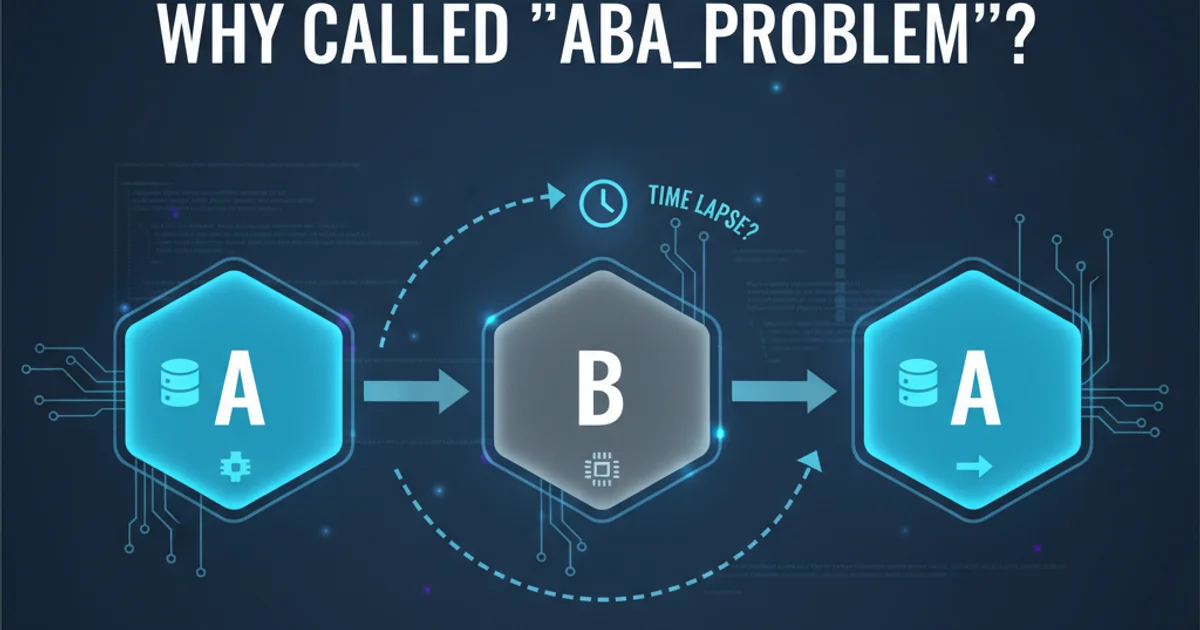Why called "ABA_problem"?
Categories:
Understanding the ABA Problem in Concurrency

Explore the ABA problem, a subtle but critical concurrency issue, its causes, implications, and common solutions using compare-and-swap (CAS) operations.
In the realm of concurrent programming, ensuring data integrity and correctness is paramount. One of the more insidious challenges developers face is the "ABA problem." This issue arises in lock-free algorithms, particularly those relying on atomic operations like Compare-And-Swap (CAS). While CAS is a powerful tool for achieving concurrency without traditional locks, it has a blind spot that can lead to unexpected and incorrect behavior: the ABA problem.
What is the ABA Problem?
The ABA problem occurs when a memory location is read to have value A, then modified to value B, and then modified back to value A. A subsequent atomic operation, such as CAS, might observe that the value is still A and incorrectly conclude that no change has occurred, even though the value has been modified twice in between. This can lead to logical errors, especially when the identity of the value (e.g., a pointer) matters more than its current content.
sequenceDiagram
participant Thread1
participant Thread2
participant Memory
Note over Memory: Initial Value: A
Thread1->>Memory: Read Value (A)
activate Thread1
Thread2->>Memory: Read Value (A)
activate Thread2
Thread2->>Memory: Write Value (B)
Thread2->>Memory: Write Value (A)
deactivate Thread2
Thread1->>Memory: CAS(expected=A, new=C)
Note over Thread1: CAS succeeds, but intermediate changes were missed.
deactivate Thread1Sequence diagram illustrating the ABA problem with two threads.
Consider a scenario where a thread reads a pointer P pointing to object X. Before this thread can perform an update, another thread deallocates X, allocates a new object Y at the same memory address, and then Y is also deallocated, and finally, a new object Z is allocated at the same address, which happens to have the same value as X (or at least, the same pointer value). When the first thread attempts its CAS operation, it sees P still pointing to X (because Z is at the same address and has the same value), and the CAS succeeds. However, the underlying object has changed, leading to a stale pointer or corrupted data.
Why is it a Problem?
The core issue is that CAS operations only compare the value at a memory location, not its history. If the value cycles back to its original state, CAS cannot detect the intermediate modifications. This is particularly problematic in scenarios involving linked lists, stacks, or queues implemented using lock-free techniques, where pointers are frequently manipulated. If a node is removed and then a new node is added at the same memory location, a CAS operation might incorrectly assume the original node is still present, leading to data corruption or logical errors in the data structure.
Solutions to the ABA Problem
Several techniques can mitigate or solve the ABA problem, primarily by adding more information to the atomic comparison.
1. Tagged Pointers (Double-Word CAS)
The most common solution involves using "tagged pointers" or a "double-word CAS" (DCAS). Instead of just comparing the pointer value, you compare both the pointer and a version counter (or tag) that is incremented every time the memory location is modified. If the pointer changes from A to B and back to A, the tag will have changed, making the CAS operation fail. Many modern processors provide a DCCAS (Double Compare-and-Compare-and-Swap) or similar instruction that can atomically update two adjacent memory locations.
struct Node {
int value;
Node* next;
};
// Represents a pointer and a version tag
struct TaggedPointer {
Node* ptr;
unsigned int tag;
};
// Example of a CAS-like operation with a tag
bool compare_and_swap_tagged(
TaggedPointer* addr,
TaggedPointer expected,
TaggedPointer new_val
) {
// This would typically be a hardware-supported atomic instruction
// For illustration, assume it atomically compares both ptr and tag
if (addr->ptr == expected.ptr && addr->tag == expected.tag) {
addr->ptr = new_val.ptr;
addr->tag = new_val.tag;
return true;
}
return false;
}
Conceptual C++ code for a tagged pointer and its CAS operation.
2. Hazard Pointers and RCU
For more complex lock-free data structures, techniques like Hazard Pointers or Read-Copy-Update (RCU) can be used. These methods ensure that memory referenced by active threads is not prematurely deallocated and reused. Hazard Pointers allow threads to register pointers to objects they are currently accessing, preventing those objects from being reclaimed. RCU defers the reclamation of old data until all readers have finished accessing it.
Understanding the ABA problem is crucial for anyone designing or working with lock-free concurrent algorithms. While CAS is a powerful primitive, its limitations must be acknowledged and addressed to ensure the correctness and robustness of concurrent systems.